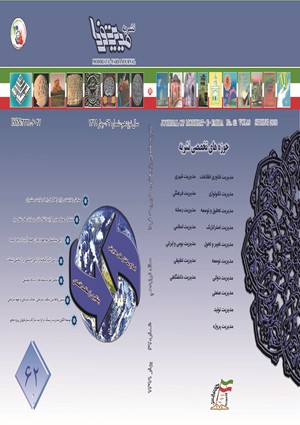الگوی ترکیبی بسط عملکرد کیفیت و مهندسی کانسی در طراحی احساسگرا با رویکرد مدلهای تصمیمگیری گروهی
محورهای موضوعی : مدیریت صنعتی
غلامرضا هاشم زاده
1
![]() ,
محمدرضا بهرامی
2
,
فاطمه سادات یزدانی
3
,
محمدرضا بهرامی
2
,
فاطمه سادات یزدانی
3
1 - تهران
2 - دانشگاه آزاد اسلامی واحد تهران جنوب
3 - دانشگاه آزاد اسلامی واحد علوم و تحقیقات
کلید واژه: مهندسی کانسی بسط عملکرد کیفیت (QFD) طراحی محصول خانه کیفیت,
چکیده مقاله :
روشهای بسیاری برای ارتقا کیفیت طراحی و ساخت محصولاتی که بیشتر با نیازهای مشتریان منطبق باشد وجود دارد. یکی از چالشهای سازمانها درک نیازهای فعلی و آتی مشتریان است. مطالعات ثابت کرده که بهجز توجه به نیازهای مشتریان، احساسات مشتری نیز در طراحی محصولات نقش بسزایی دارد. یکی از روشهای مؤثر برای شناسایی و استفاده در طراحی محصول مهندسی کانسی است. در این تحقیق تلاش شده که از روش بسط عملکرد کیفیت نیازهای مشتریان و از مهندسی کانسی احساسات مؤثر بر طراحی محصول تعیین و با ترکیب این دو بتوان محصولاتی هر چه بیشتر منطبق بر نیازهای مشتریان طراحی نمود. در این تحقیق ابتدا با کمک بررسی تحقیقات ، لغات کانسی در رابطه با محصول جمعآوری و از بین آنها 13 لغت که بیشترین تأثیر را روی مصرفکنندگان داشته، انتخاب گردیدند. سپس طی یک مصاحبه با فروشندگان، خواص فنی محصول تعیین و پرسشنامهای بین 50 نفر توزیع گردید که طی آن از کاربران درخواست شد تعیین کنند چه ویژگیهایی از محصول برای ایشان اهمیت بیشتری دارد. برای مشخص شدن وزن خواص، پرسشنامه مقایسه زوجی برای فروشندگان طراحی و استفاده شد که توسط ANP مورد تحلیل قرار گرفت. با توجه به نتایج طرح جدیدی برای ظرف مایع ظرفشویی ارائه گردید.
There are many ways to improve the quality of designing and manufacturing products that are more in line with the needs of customers. Studies have shown that, in spite of customer needs, customer sense also plays a major role in designing products. One of the effective ways to identify and use in product design is kansei engineering. In this research, we have tried to use quality function deployment (QFD) and kansei engineering to determine the emotions affecting the design of the product and by combining these two, products can be tailored to meet the needs of customers. The statistical population for the determination of technical properties was the stores that were classified according to the sampling method in each case; a simple sampling method was chosen among buyers. Then, during the interview, 10 prominent vendors with a history of selling health products were used. The technical properties of the product are determined in the form of 21 items and a questionnaire distributed among 50 people in which users were asked to determine what characteristics of the product are more important to them. In this research, firstly, with the help of the previous study, the kansei words were collected in relation to the product, and 13 of them were chosen. These factors were classified into three categories of sensory and appearance features, inherent features and controllable factors. According to the results of a new design for a dishwashing liquid container Presented.
آل علی فرهاد، بررسی شناخت تأثیرات احساسی و عاطفی محصولات بر کاربران و مصرفکنندگان و تبدیل آنها به پارامترهای طراحی در طراحی صنعتی،1391، همایش ملی فناوریهای نوین در صنعت لوازمخانگی.
کلینى ممقانى ناصر و مهدی خرم، اثرگذارى و نقش احساس در فرایند طراحى محصول، درآمدى بر روششناسی مهندسى کانسى، 1387، نشریۀ بینالمللی علوم مهندسى دانشگاه علم و صنعت ایران، جلد 19، شماره 10, 160-151.
Akao,Yoji & Shigeru,Mizuno,1994, “QFD: The Customer-driven approach to quality planning and development”.
Dahlgaard, Jens J, Schutte, Simon & Ayas, Ebru,2008, Kansei/affective engineering design: A methodology for profound affection and attractive quality creation.
Grimsaeth, Kjetil, 2005, Kansei Engineering, www.ivt.ntnu.no. Norwegian
Hartono, M. & Chuan, T.K,2011, How the Kano model contributes to Kansei engineering in services. Ergonomics, 54 (11): 987–1004.
Hashemzadeh, gh. & Zeynali, M.,2014, “Determination and Prioritization of Product Design Specifications with Kansei Engineering Approach; Case Study: Packing Designation of new Health, Kuwait Chapter of Arabian Journal of Business and Management Review, 3(7): 153-169.
Linares, G. & Page, A,2011, Kano’s model in Kansei Engineering to evaluate subjective real estate consumer preferences. International Journal of Industrial Ergonomics, 41(3): 233-246.
Ming-Shyan Huang, Hung-Cheng Tsai & Wei-Wen Lai,2012, Kansei Engineering Applied to the Form Design of Injection Molding Machines, Taiwan (China), pp.198-208.
Nagamachi, M,2002, “Kansei engineering as a powerful consumer oriented technology for product development”, Applied Ergonomics, 33 )3:(289-294.
Reilly, Norman B, 1999, The Team based product development guidebook, ASQ Quality Press, Milwaukee Wisconsin.
Revelle, J. B. Moran, J. W. Cox, C. A. 1998, "The QFD Handbook “John Wiley & Sons.
Schutte, Simon,2002, Designing Feelings in to Products, M.S. Thesis, Linkoping University, Sweden.
Schütte, S, 2005, Engineering emotional values in product design. Kansei Engineering in development. Linköping University, Linköping.


